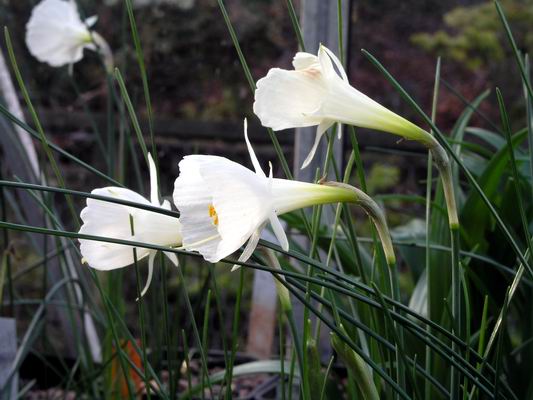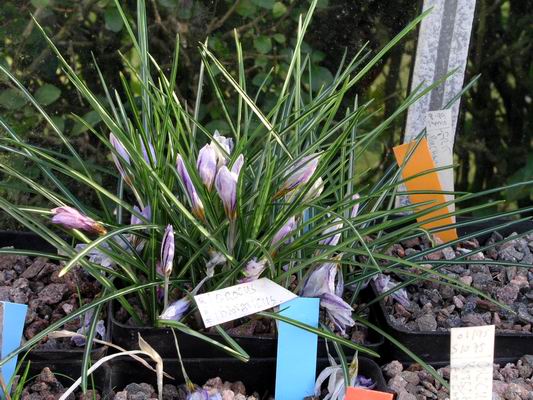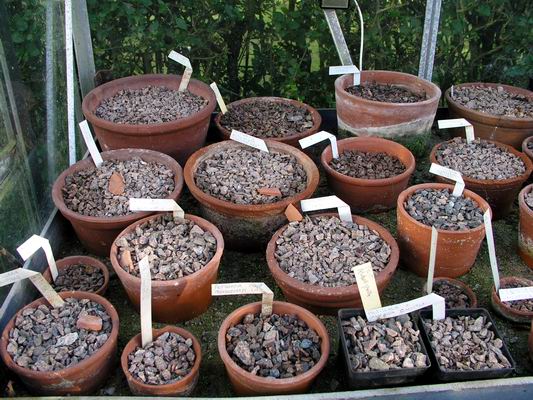|
BULB LOG 48 - 1st December 2005

Arum creticum and Cyclamen persicum
The hardiness of a plant is dependant on many factors; it is not as simple as the lowest temperature that it can survive. We have both Arum creticum and Cyclamen persicum growing outside in a south facing well drained bed - it is the well drained bit that is important. Plants can tolerate freezing when the water levels are low - they are much more likely to be damaged if their cells are full of water. It is the expansion and contraction of the water within the plants' structure as it turns to ice and back, that ruptures the plant cells that causes the damage. The aspect is another factor of hardiness; a frozen plant needs to defrost slowly and if the sun hits them early in the morning they are again more likely to sustain damage than they are if they thaw out very slowly.

Laperousia laxa and seed
Another unlikely survivor in this bed is Laperousia laxa which still has a few flowers on despite the low temperatures (-6C) we have had recently. This small Mexican bulb has survived with us for 20 plus years, mostly from self sown seedlings. I have been scattering the seed back into this narrow south facing bed and in the next few years we should have masses of them.

Cyclamen with floppy leaves
Moving inside, the same conditions of freezing affects the plants but I have the ultimate control on the moisture levels. When to water the bulbs in the winter is never an easy decision; the very erratic temperatures that we get throughout the winter months make it very difficult to know when it is best to water the bulbs. This Cyclamen africanum has very floppy leaves indicating that it needs a good watering, but, our weather forecast predicts cold conditions for the next few days so, even though today is bright and not freezing, I am delaying watering until later in the week when the temperatures are set to turn milder with a lesser risk of freezing. Inevitably whenever I water the bulbs during the winter, a freeze sets, in that is just sods law and I have to get water into them sometime. How much better it would be if our winters produced a freeze for three months: that would hold the bulbs, then a thaw followed by a nice bright sunny spring for them to spring into flower and set seeds - dream on!

Narcissus cantabricus
The damaging effects of the freezing can be seen on one of the flowers (right) on this Narcissus cantabricus. I think that this damage is also partially due to another factor in the hardiness equation that affects the flowers rather than the whole plant. The fact is that this flower has done its job, having been out for a while; it has been fertilised and I hope is now setting seed. The other flowers that have not been fertilised yet show no signs of damage. Fading flowers seem to have a higher water content than their fresher companions; perhaps this is because their cells are already starting to break down.

Crocus laevigatus
We can see this very clearly in crocus flowers that are going over - they turn into a soggy mess and have to be removed to help prevent botrytis taking over. This pot of Crocus laevigatus shows both old soggy flowers that need removed now, alongside a second flush of flowers that are yet to open.

Narccissus x3
The best indicator of when the bulbs need watering comes from the plants themselves; look at their leaves. The pot on the left has very upright turgid leaves while the leaves in the middle pot are just starting to flop over showing that they are lacking in moisture. The pot on the right has much less leaf growth and so it will require much less regular watering because it is mostly losing fluid by evaporation unlike the other two pots that have a lot of leaves all transpiring and pumping water out of the compost.

Pots on shallow tray
Another factor that affects the regularity of watering is the plunge depth. The bigger the volume of sand you have in the plunge the larger will be the reservoir of moisture. The pots above are sitting on barely 1cm of sand in a shallow tray which hardly holds any moisture so it needs watered more frequently.

Sand plunge
These pots are sitting on a about 10cms of sand and so need less frequent watering.

Ipheion leaves
This Ipheion has lots of broad leaves that transpire a lot of water, so need regular watering. This is why my rule for watering bulbs, after the two autumn storms, is to water in proportion to the amount of leaves - a lot of leaves will require more watering than a pot with only a few leaves.

Narcissus plunge
Most of our "plunges" that the plastic pots sit on, are around 10cms deep. Ideally the deeper the plunge sand is the better, as the bigger volume provides a more stable environment to the plunged pots. Our plunges are a compromise as I want to use the area below the plunges as well and this means I need access and head height to allow some light in. These Narcissus, unlike the ones on the very shallow tray, are not showing any signs of requiring watering yet.

Crocus cambessedesii leaves
The narrow leaves of Crocus cambessedesii use water up more slowly than other crocus species that have broad leaves - undoubtedly an adaptation to the climate in their natural habitat of the Balearic Islands. Using a standard selection of square plastic pots means there are no gaps between them so they become self plunging and just need to sit on a bed of sand unlike round pots which need sand, or other material, around them at depth to fill out the gaps.

Fritillaria house
I am slowly going over to all square plastic pots but still use some round clay pots for the frits. These need more depth so that as much of the pot can be buried in the plunge material as is practical. To save weight I tend not to plunge pots up to the rim, as is often pronounced as the best method, instead I plunge deep enough to ensure that the level that the bulbs are at in the pots is at least a couple of centimetres below the plunge level. This helps protect the bulbs from excessive swings in temperature, especially freezing, as well as helping to balance out the changes in moisture level. As you can observe there are no signs of growth showing in the frits, but they will have roots and shoots slowly expanding so still need to be kept moist at all times. Having carried out the two autumn soakings I just water the plunge occasionally if it shows signs of drying out.

Weeds in frit pots
I do not sterilise our loam when I mix the compost so always get some weed growth in the pots. While I remove most of them I always leave a few as they are a good indicator that there is sufficient moisture in the pots to sustain the slow frit growth at this time of year.

Tecophilaea cyanocrocus shoots
The first shoots on our Tecophilaea cyanocrocus are just showing now, but again, watering is not applied directly. These pots are in the plunge with the frits and are getting sufficient moisture from the continually moist plunge: as soon as leaf growth starts I will water directly into the pot.

Narcissus romieuxii
The swinging temperatures at this time of year also causes uneven flowering in most pots of Narcissus. The first flowers here opened in the milder days of October and early November then the freeze started and everything slowed right down again leaving many buds unopened. According to the forecasters we are heading back into a milder period so I can look forward to lots more narcissus flowers in the coming weeks and months.
^ back to the top ^
|

